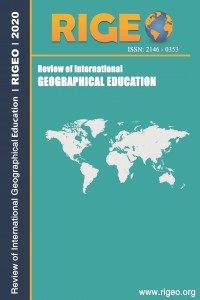Geography of Education
Geography of Education
Geography of Education is an important book. It is important for several reasons, not
the least being Colin Brock’s considerable background in international and comparative
education and his understanding and appreciation of geography as a discipline and its
relevance in and to studies of education. The increasing emphases on place and space in
education, in relation to the sites of education, learning in formal and informal situations,
the range of scales at which education can be examined, and the variety of locations for
research are drawn together in this book. It is global in scope and offers perspectives on
diversity and sustainability alongside development and internationalization. Brock makes
the point (p.9) that this book is for educators and geographers, arguing that both need to
recognize the pertinence of studies of place, scale, space and location that are inherent in
educational provision and activities. Geography is taught in schools and other institutions
across the globe in one context or another, and geography is necessary in understanding
where children and young people are educated, their access to education, the resourcing of
education and local and national policies that affect their education.
Keywords:
Colin Brock,
___
- Adnett, N. & Davies, P. (2002). Markets for Schooling: An economic analysis. Abingdon: Routledge.
- Bonnett, A. (2008). What is Geography? London: Sage.
- Brock, C. (2011). Education as a Global Concern. London: Continuum.
- Brock, C. (2013). Education Around the World: A Comparative Introduction. London: Bloomsbury.
- Brooks, R., Fuller, A. & Waters, J. (Eds.) (2012). Changing Spaces of Education: New perspectives on the nature of learning. Abingdon; Routledge.
- Clarke, L. (2016). Teacher Status and Professional Learning: The Place Model. Northwich: Critical Publishing.
- Cresswell, T (2015). Place: An Introduction. Hichester: Wiley-Blackwell.
- Dolan, J. (2001). Geographies of Learning: Theory and practice, activism and performance. Middletown, Con: Wesleyan University Press.
- Dorling, D & Lee, K. (2016). Ideas in Profile: Geography. London: Profile Books
- Ellsworth, E. (2005). Places of Learning: Media, Architecture, Pedagogy. New York: Routledge.
- Furlong, J. & Lawn, M. (Eds.) (2011). Disciplines of Education: Their role in the future of educational research. Abingdon: Routledge.
- Gruenewald, D. & Smith, G. (Eds.) (2008). Place-based Education in the Global Age: Local Diversity. New York: Lawrence Erlbaum.
- Gulson, K. & Symes, C. (Eds.) (2007). Spatial Theories of Education: Policy and geography matters. Abingdon: Routledge.
- Hernandez, F. & Goodson, I. (Eds.) (2002). Social Geographies of Educational Change. Dordrecht: Klewer.
- Hutchinson, D. (2004). A Natural History of Place in Education. New York: Teachers College, Columbia University.
- Jackson, P. (2006). Thinking geographically. Geography, 91 (3), pp.199-204.
- Pe Symaco, L. & Brock, C. (Eds.) (2016). Space, Place and Scale in the Study of Education. Abingdon: Routledge.
- Sobel, D. (2013). Place-based Education: Connecting classrooms and communities. (2nd edition) Great Barrington, Mass: Orion.
- Somerville, M., Power, K & de Carteret (Eds.) (2009). Landscapes and Learning: Place studies for a global world. Rotterdam: Sense Publishers.
- Taylor, C. (2002). Geography of the ‘New’ Education Market: Secondary school choice in England and Wales. Aldershot: Ashgate.
- Taylor, C. (2011). Towards a Geography of Education. In J. Furlong & M. Lawn (Eds.). Disciplines of Education: Their role in the future of educational research (pp.122-142). Abingdon: Routledge.
- ISSN: 2146-0353
- Başlangıç: 2011
- Yayıncı: Eyüp ARTVİNLİ
